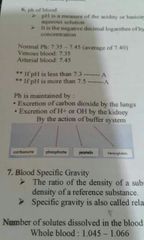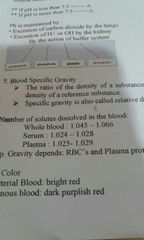![]()
![]()
![]()
Use LEFT and RIGHT arrow keys to navigate between flashcards;
Use UP and DOWN arrow keys to flip the card;
H to show hint;
A reads text to speech;
73 Cards in this Set
- Front
- Back
|
Describe wormd in the blood |
Athanasius Kircher |
|
|
Discovery of erythrocytes |
Swammerdam |
|
|
Describe human erythrocytes |
Van Leuwenhoek |
|
|
Year when platelets were described |
1842 |
|
|
PMN distinguished from other leukocytes |
Wharton Jones (1846) |
|
|
First complete classification of leukocytes |
Ehrlich 1879 |
|
|
Development of wrights stain |
James Homer Wright 1902 |
|
|
1920 |
Hematology was considered a separate science from clinical pathology |
|
|
dys |
Abnormal |
|
|
Emia |
In the blood |
|
|
Myelo |
Marrow |
|
|
Normo |
Normal |
|
|
Like |
Oid |
|
|
FBC |
Full Blood Count |
|
|
Fl |
Femtoliter |
|
|
Hb |
Hemoglobin concentration |
|
|
Hct |
Hematocrit |
|
|
MCH |
Mean Cell Hemoglobin |
|
|
MCV |
Mean Cell Volume |
|
|
MCHC |
Mean Cell Hemoglobin Concentration |
|
|
PG |
Picogram |
|
|
Life sustaining fluid which circulates thru the heart and blood vessels |
Blood It carries oxygen and nutrients to the tissues and waste products to the lungs, liver, and kidney where they can be removed from the body. |
|
|
Blood Composition |
Formed elements Plasma |
|
|
Formed elements |
Erythrocytes Leukocytes Thrombocytes |
|
|
Liquid portion of unclotted blood |
Plasma |
|
|
The fluid that remains after coagulation has occurred and clot has formed |
Serum |
|
|
Percentage of water in plasma |
90% |
|
|
Other components of plasma aside from water |
Proteins Enzymes Hormones Lipids Salts |
|
|
Normal color of plasma |
Hazy and pale yellow |
|
|
Normal appearance of serum |
Clear and straw colored |
|
|
Plasma contains... |
Fibrinogen which is an anticoagulant factor |
|
|
5 parameters of CBC |
HgB Hct WBC RBC Differential count |
|
|
Increase WBC count could indicate... |
Leukocytosis Leukopenia |
|
|
Used for blood indices |
Femtoliter |
|
|
Determine the type of anemia |
MCH MCV MCHC |
|
|
Measures the amount of packed red cells |
Hct |
|
|
Used for blood indices |
Picogram Femtoliter |
|
|
Tube used for serum |
Plain tube Red tap |
|
|
Coagulation factors are written in what? |
Roman Numerals |
|
|
Factor 1 |
Fibrinogen |
|
|
Factors present in serum which are completely consumed in the coagulation process |
FI FV FVIII FXIII |
|
|
Portion of factor II thst remains in serum |
Residual Prothrombin |
|
|
Not completely consumed. >80% is consumed and <20% remains in serum |
FII |
|
|
Buffy coat components |
Leukocytes Platelets <1% of total blood |
|
|
55% of total blood |
Plasma |
|
|
45% of the total blood |
Erythrocytes |
|
|
Stuart-Prower Factor |
Factor X |
|
|
Fibrin-Stabilizing Factor |
Factor XIII |
|
|
Factor V |
Proaccelerin |
|
|
Factor II |
Prothrombin |
|
|
In vitro, blood coagulates in... |
5-10 mins |
|
|
Blood is .... thicker than water |
3.5-4.5 times |
|
|
Blood makes up how many percent of the total body component |
6-8% or 60-80ml/kg |
|
|
Total Body Volume |
Adult male: 5-6L Adult female: 4-5L Newborn: 250-350 mL |
|
|
Thickness or stickness of blood |
Blood viscosity |
|
|
Blood viscosity |
Resistance of blood to flow |
|
|
Viscosity of blood is ... times more than that of water |
5 |
|
|
Blood Viscosity depends on... |
RBCs Plasma proteins |
|
|
General characteristics of blood |
1. In vivo, blood is in fluid; in vitro it coagulates in 5-10 minutes 2. Thick and viscous 3.5-4.5 times thicker than water 3. Makes up 6-8% of the total body component or 60-80ml/kg 4. Approximately 20 gms solid per 100 ml 5. Total Blood Volume AM: 5-6L AF: 4-5L Newborn: 250-350 mL |
|
|
Measure of the acidity or basicity of an aqueous solution |
pH |
|
|
The negative decimal logarithm of H concentration |
pH Potential of Hydrogen |
|
|
Normal blood pH |
7.35-7.45 Average of 7.40 Venous blood: 7.35 Arterial blood: 7.45 |
|
|
How is blood pH maintained? |
Excretion of CO2 by the lungs Excretion of H+ or OH by the kidney by the action of buffer system |
|
|
Buffer system |

Hemoglobin Protein Phosphate Carbonate |
|
|
The ratio of the density of a substance to the density of a reference substance |
Blood Specific Gravity |
|
|
Other name for BSG |
Relative density |
|
|
SG depends on... |
RBCs Plasma proteins |
|
|
Number of solutes dissolved in the blood |

|
|
|
Pigments Arterial blood Venous blood |
Bright red Dark purplish red |
|
|
Pigments in pulmonary arteries and veins |
Hb with O2 : purple Hb without O2: blue |
|
|
Concentration of solutes dissolved in blood |
Osmolality |
|
|
Measurement used for osmolality |
Osmometer MEASUREMENT RANGE: 281-297 milli-osmoles per kilogram (mOsms) |
|
|
Function of Blood |
Respiratory Nutritional Excretory Buffer action Maintenance of constant body temp Transportation of hormones and other endocrine secretion that regulates cell function Body defense mechanism |

